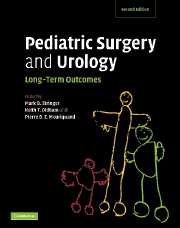Book contents
- Frontmatter
- Contents
- List of contributors
- Acknowledgments
- Preface
- Part I General issues
- Part II Head and neck
- Part III Thorax
- Part IV Abdomen
- 20 Abdominal surgery: general aspects
- 21 Abdominal wall defects
- 22 Inguinal and umbilical hernias
- 23 Infantile hypertrophic pyloric stenosis
- 24 Small bowel disorders
- 25 Cystic fibrosis
- 26 Necrotizing enterocolitis
- 27 Inflammatory bowel disease in children
- 28 Intestinal failure
- 29 Appendicitis
- 30 Hirschsprung's disease
- 31 Anorectal malformations: experience with the posterior sagittal approach
- 32 Gastrointestinal motility disorders
- 33 The Malone antegrade continence enema (MACE) procedure
- 34 Splenectomy
- 35 Biliary atresia
- 36 Choledochal cyst
- 37 Biliary stone disease
- 38 Portal hypertension
- 39 Persistent hyperinsulinemic hypoglycemia in infancy
- 40 Acute and chronic pancreatitis in children
- Part V Urology
- Part VI Oncology
- Part VII Transplantation
- Part VIII Trauma
- Part IX Miscellaneous
- Index
- Plate section
- References
31 - Anorectal malformations: experience with the posterior sagittal approach
from Part IV - Abdomen
Published online by Cambridge University Press: 08 January 2010
- Frontmatter
- Contents
- List of contributors
- Acknowledgments
- Preface
- Part I General issues
- Part II Head and neck
- Part III Thorax
- Part IV Abdomen
- 20 Abdominal surgery: general aspects
- 21 Abdominal wall defects
- 22 Inguinal and umbilical hernias
- 23 Infantile hypertrophic pyloric stenosis
- 24 Small bowel disorders
- 25 Cystic fibrosis
- 26 Necrotizing enterocolitis
- 27 Inflammatory bowel disease in children
- 28 Intestinal failure
- 29 Appendicitis
- 30 Hirschsprung's disease
- 31 Anorectal malformations: experience with the posterior sagittal approach
- 32 Gastrointestinal motility disorders
- 33 The Malone antegrade continence enema (MACE) procedure
- 34 Splenectomy
- 35 Biliary atresia
- 36 Choledochal cyst
- 37 Biliary stone disease
- 38 Portal hypertension
- 39 Persistent hyperinsulinemic hypoglycemia in infancy
- 40 Acute and chronic pancreatitis in children
- Part V Urology
- Part VI Oncology
- Part VII Transplantation
- Part VIII Trauma
- Part IX Miscellaneous
- Index
- Plate section
- References
Summary
The management of anorectal malformations has, for many years, been a challenge for pediatric surgeons The most common and feared sequela is fecal incontinence. Urinary incontinence, sexual inadequacy, and fertility problems may also affect patients born with these defects.
Long-term outcomes in all congenital defects have been neglected by the pediatric surgical community, mostly because of the difficulty of follow-up. Also, once the patients reach a certain age they are no longer considered “pediatric” surgical patients, and they see adult specialists who continue their care. This seems true for all congenital defects, but with anorectal and genital malformations, long-term follow-up seems to be even more difficult to achieve, perhaps because the patients protect their privacy and do not like to disclose what could be considered embarrassing. Once patients reach puberty and/or adolescence they tend to hide their problems because the functional sequelae of an anorectal malformation are considered shameful. As a consequence, publications related to the long-term outcome of these patients have been rather scarce.
Learning about the long-term functional sequelae suffered by these patients is mandatory for all pediatric surgeons in order to plan strategies for their management. The prevention and treatment of these functional sequelae is much more challenging, demanding, and expensive than the anatomical reconstruction upon which we have previously placed such emphasis. The challenge for the new generation of pediatric surgeons rests in understanding the intrinsic mechanisms of functional disorders that can be determined only through basic science research.
- Type
- Chapter
- Information
- Pediatric Surgery and UrologyLong-Term Outcomes, pp. 401 - 415Publisher: Cambridge University PressPrint publication year: 2006
References
- 5
- Cited by

